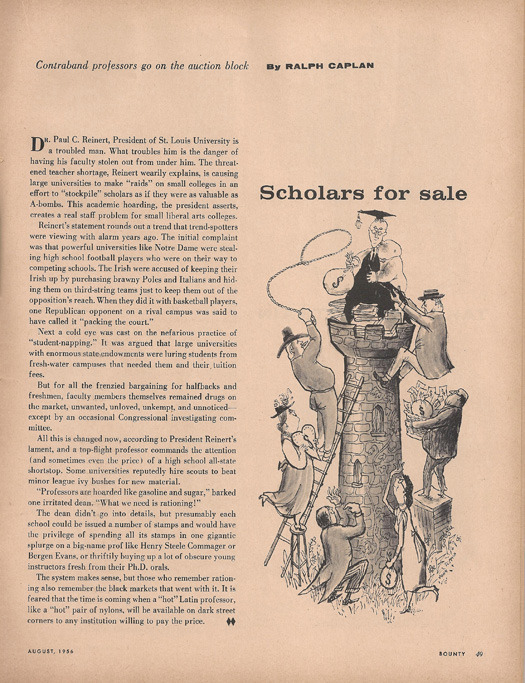
My favorite James Thurber stories are those that famously betray their titular promise. "The Night the Bed Fell on Father", for example, describes an episode in which nothing falls on Father, who is asleep in the attic during the entire episode. In "The Night the Ghost Got In," no ghost gets in, and in "The Day The Dam Broke, the dam remains intact and Columbus, Ohio is not washed away.
So it may be perverse but not surprising that my contribution to a series on "my first design-related job" is about a job that had nothing to do with design.
When I came to New York in 1955 I was hired as a staff writer on a putatively satirical magazine just being formed. I had been recommended by a friend whose landlady was the assistant to the publisher, a Czechoslovakian war veteran with no background in either humor or publication.
The magazine was called Bounty. The closest link to a design connection was the art director, Phil Franznick. Having never worked on a magazine before, I had only a vague idea of what an art director was or did. I particularly appreciated Franznick, however, because he assigned an artist named Bob Guccione (yes, that one) to illustrate my articles.
Those I actually remember writing dealt with computers, which were at the time frequent objects of satire and mockery. Massive, unfriendly assemblages said to perform marvels few of us dared to take seriously, they threatened to mechanize human experience and, we feared, human beings. Those in the know already called them computers. To the rest of us they were "IBM machines."
The writers and art director at Bounty had very little contact with each other, so I was surprised one day when Phil asked me to help him with a problem. Someone had submitted a portfolio of cartoons that he thought were brilliant, but that the publisher rejected. I pointed out that I had no special influence with the publisher, who I was not even sure liked me. Phil said he knew that, but all the other writers had declined. I was the last choice.
He laid a thick folder on my desk labeled SICK SICK SICK. In it was a treasure trove of funny strips that in both image and text captured perfectly the culture we were living in. At least the culture I was living in then, in Greenwich Village on Waverly Place, a block from Washington Square.
I rushed into the publisher's office and said, "Phil just showed these to me. We have to use them."
He shook his head glumly and said, " What's funny about sick?"
The cartoons, the work of a young freelance artist named Jules Feiffer, soon appeared in the Village Voice, and later as the seminal book Sick, Sick, Sick: A Guide to Non-Confident Living.
Feiffer was not the only star about-to-be-born whose light was unrecognized by Bounty. Edward Gorey was another. With editorial calls like those it is small wonder that the magazine's own light was itself extinguished after only four issues. The magazine folded and so, I was afraid, would I. The staff scurried off to whatever jobs we could find.
Although the first one found was on the infamous Confidential, most of us ended up OK. Guccione went to England and founded Penthouse. Franznick became president of an ad agency. Tom Meehan wrote the book for the musical "Annie" and co-wrote the book for "The Producers." The late Lou Botto was at Interiors and Look, before settling in for 40 years as editor of Playbill.
As for me, I finally stumbled into a job that was design related. The same friend who sent me to Bounty knew an editor at Industrial Design who was about to leave. I had never heard of the magazine, and barely had heard of the field, but I applied. When asked to describe my experience in writing about design, I admitted that I had none. But, although it was a stretch, I said I had written about designed products, offering as evidence two of the illustrated satirical pieces on computers.
After a battery of interviews and trial assignments, I was hired. Since nothing in my background was even remotely design-related I concluded that the illustrations, and therefore the art direction, leveled the playing field as politicians say.
It is a field I have played on ever since.
— Ralph Caplan
